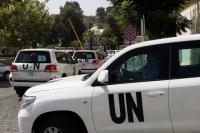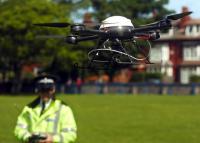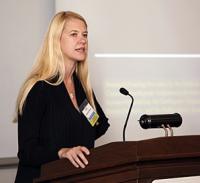-
Ex-Shin Bet chief: Hezbollah “learning to fight on a large scale” in Syria, threatening Israel
The Iran-backed terror group Hezbollah is gaining valuable experience while “learning to fight on a large scale” in Syria, a former Shin Bet chief told a visiting delegation of U.S. congressional advisers last Monday. Avi Dichter, currently the chairman of the Knesset’s Foreign Affairs and Defense Committee, said Hezbollah in Syria is “learning to fight on a large scale, in platoons and battalion, while using sophisticated weaponry and heavy, precise arms that they receive from Iran.” These new capabilities will ensure that the “next round” in the conflict between Hezbollah and Israel will be much different.
-
-
Israeli tech company’s spyware turns UAE activist’s iPhone into a self-tracking device
Two University of Toronto researchers have uncovered an iPhone-based attack on Ahmed Mansoor, a prominent United Arab Emirates human rights defender. The attack employed spyware produced by NSO Group — an Israeli technology company founded by former members of Unit 8200, the Israeli military’s electronic surveillance branch – which is sold to government for the purpose of spying on their citizens.
-
-
Watchdog: Evidence suggests Assad kept chemical weapons program in violation of 2013 deal
After launching a lethal sarin gas attack in August 20013 — which killed 1,400 Sunni civilians in a Damascus suburb — the Assad regime agreed to get rid of its nerve agents under the supervision of OPWC, the UN chemical weapons watchdog. In summer 2014 OPCW announced that Syria’s declared chemical weapons stockpile had been removed – but in a classified report submitted Wednesday to the Security Council, OPWC says that Syria has violated the 2013w agreement by keeping some of its chemical weapons program, and by continuing to use chemical weapons in attacks against civilians.
-
-
Can we get better at predicting earthquakes?
In the wake of the deadly earthquake, measuring 6.2, which rocked central Italy in the early hours of 24 August, questions again have been raised about whether earthquakes can be predicted. Fortunately, all earthquakes do not lead to disasters and, therefore, understanding where and why disasters are produced is the first goal of earthquake seismology. The first issue is thus one of semantics and objectives. Is the goal to predict an earthquake occurrence, predict ground motion due to an earthquake, or predict a disaster? In our efforts to better predict earthquakes, we have to be precise about the timescale: is it a prediction that an earthquake is imminent – that is, within seconds, hours, or even days before the shaking? Or that it is likely to happen within years or tens of years? There is hope that one day we could detect and monitor extremely slight changes in the rocks that would precede earthquakes – but this is still a long way from “prediction” of precisely when and where a disaster will occur. For now, knowing earthquakes is one way to live with them, to be prepared, to know the vulnerability of our communities and to adopt sound policies for earthquake-safe environments.
-
-
Nuclear forensics summer program trains students for a future in nuclear security
A sure sign of summer is the return of interns to the Lawrence Livermore campus. Students interact with premier researchers and access equipment and facilities not available anywhere else, while scientists lay groundwork for advancing their fields. LLNL runs an eight-week summer internship for students interested in nuclear science and its range of specialties — nuclear forensics, environmental radiochemistry, nuclear physics, and beyond. Together, these disciplines support the laboratory’s nuclear security mission through analysis of nuclear processes and properties.
-
-
U.S. has given 1.4 million guns to Iraq, Afghanistan -- but doesn’t know where, by whom these weapons are currently being used
The United States has given more than 1.4 million guns to Iraqi and Afghan forces, as part of the more than $40 billion worth of U.S. Department of Defense arms and munitions contracts since 9/11. The Pentagon has only partial, and not necessarily accurate, information not only about the total number of firearms involved, but how, where, and by whom these weapons are currently being used. Journalists have offered evidenced that many firearms openly available for purchase on black markets and on social media throughout the Middle East were originally provided by the Pentagon to U.S. associates in Iraq and Afghanistan.
-
-
Iran threatened to halt nuke talks if U.S. bombed Assad, WSJ reporter says

President Barack Obama changed his mind about launching a retaliatory strike against Syrian President Bashar al-Assad, whose forces carried out a sarin gas attack that killed more than 1,400 people in August 2013, after Iran threatened to pull out of then-secret nuclear talks, the chief foreign correspondent for the Wall Street Journal said on Monday.
-
-
French schools to hold security drills, including mock terrorist attacks
As part of the French government’s bolstering of security measures in the wake of a series of terrorist attacks, French schools, beginning with the new school year, will now conduct three security drills a year – including at least one drill in which a mock assailants enter the school building.
-
-
Many sections of Baltimore are under secret, constant aerial video surveillance by BPD

The Baltimore Police Department has secretly deployed a surveillance system using planes and powerful cameras that can continuously record 30-square-mile sections of the city at once. The technology, which is run by a private company, was originally developed for the Defense Department for use in Iraq. It stores the video footage for an undetermined amount of time, and police can use it to retroactively track any pedestrian or vehicle within the surveillance area.
-
-
Louisiana’s Cajun Navy shines light on growing value of boat rescuers

As we look at the devastating losses suffered by Louisiana communities from the recent flooding, one of the inspiring aspects to emerge from the disaster are the reports of the “Cajun Navy” – everyday residents in their boats checking on and rescuing family, friends, neighbors and even strangers in need. The efforts of the Cajun Navy, however, are not unusual. Indeed, one consolation of the disaster is the extent to which the informal responses by survivors bolster stressed and overburdened formal response systems. We must continue to learn the right lessons from disaster: that there is value of both planning and improvisation in disaster. That although citizens might sometimes make mistakes, they also enable the greatest of responses. That successful disaster response, in part, depends on a willingness of formal responders to acknowledge the capacities of our citizenry, be they mariners or farmers, welders or educators, or something else entirely.
-
-
Police seized drones trying to smuggle contraband into London prison
The police have seized two drones carrying drugs and mobile phones as they were making their way toward the all-male Pentonville jail in Islington, north London. Drones were increasingly being used to smuggle items into prisons in England and Wales. Figures showed there were thirty-three incidents involving devices in 2015, compared to two in 2014 and none in 2013.bDrugs, phones, mobile chargers, and USB cards were among the items discovered.
-
-
“Zombie drug” flakka causes “excited delirium,” but probably not cannibalism: Experts
It was a gruesome sight: Florida police pulled a 19-year-old Florida State University student away from the bodies of his two victims, only to find that the one of them was severely bitten in the face. Police officers say the immediately knew who (or, rather, what) the culprit was: flakka, or bath salts, a powerful man-made drug. Experts say that “bath salts” drugs can cause “excited delirium,” but probably do not drive users to cannibalism.
-
-
Data on taxi routes and points of interest could improve crime predictions

Data on how taxis travel through communities and on how people label points of interest on social media could help analysts and criminologists better understand neighborhood crime rates in a city. Analysis of data from points of interest in Chicago — including restaurants, shops, nightclubs, and transit stations — designated by members of FourSquare, a social media site, along with the city’s taxi flow information, offered significantly more accurate estimates of crime rates compared to traditional means. Crime analysts currently mainly rely on demographic and geographic data to study crime and predict trends.
-
-
U.S. nuclear weapons in Turkey at risk of seizure by terrorists, hostile forces
The continued presence of dozens of U.S. B61 nuclear weapons at Incirlik Air Base in Turkey raises serious risks of their seizure by terrorists and other hostile forces, a new report says. These weapons no longer serve any military purpose, and ending B61 presence in Europe would save $3.7 billion over five years.
-
-
USGS awards $3.7 million to advance ShakeAlert early warning system
The U.S. Geological Survey awarded approximately $3.7 million to six universities to support transitioning the ShakeAlert earthquake early warning system into a production system. Additionally, the USGS has purchased about $1.5 million in new sensor equipment to expand and improve the ShakeAlert system and awarded about $0.25 million in supplements to earlier agreements to three universities. These efforts, as well as internal work that the USGS is conducting, are possible because of $8.2 million in funding to the USGS Earthquake Hazards Program for ShakeAlert approved by Congress earlier this year.
-
More headlines
The long view
Factories First: Winning the Drone War Before It Starts
Wars are won by factories before they are won on the battlefield,Martin C. Feldmann writes, noting that the United States lacks the manufacturing depth for the coming drone age. Rectifying this situation “will take far more than procurement tweaks,” Feldmann writes. “It demands a national-level, wartime-scale industrial mobilization.”
How Male Grievance Fuels Radicalization and Extremist Violence
Social extremism is evolving in reach and form. While traditional racial supremacy ideologies remain, contemporary movements are now often fueled by something more personal and emotionally resonant: male grievance.
The Surprising Reasons Floods and Other Disasters Are Deadlier at Night
It’s not just that it’s dark and people are asleep. Urban sprawl, confirmation bias, and other factors can play a role.
Why Flash Flood Warnings Will Continue to Go Unheeded
Experts say local education and community support are key to conveying risk.
